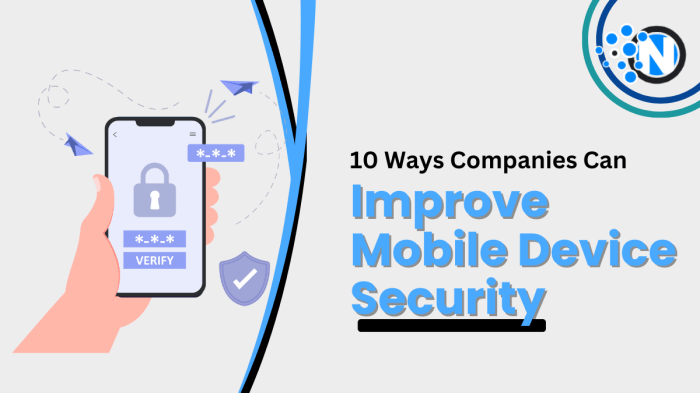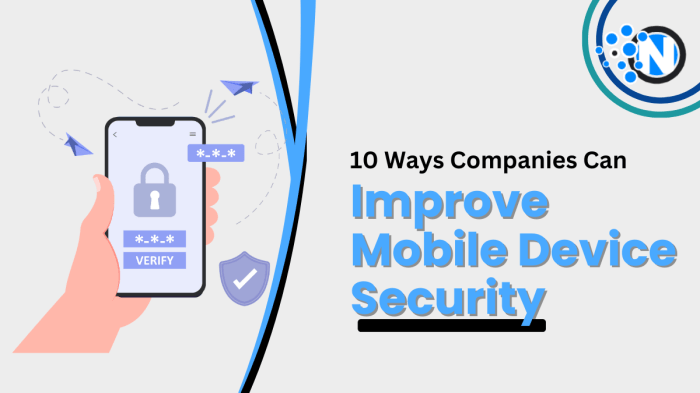Mobile Devices A Security Challenge for Companies
Mobile devices create security challenge for companies, as businesses increasingly rely on smartphones and tablets for everyday operations. From email and communication apps to accessing sensitive data, these devices are deeply integrated into corporate workflows. This integration, while efficient, introduces significant security vulnerabilities. Different types of mobile devices – smartphones, tablets, laptops – each present unique security risks.
Understanding these risks and implementing robust security measures is critical for companies to safeguard their data and operations.
The growing prevalence of mobile devices in business necessitates a comprehensive approach to security. This discussion will explore the various security vulnerabilities associated with mobile devices, from malware and phishing to unauthorized access. We’ll also examine strategies for protecting data, such as Data Loss Prevention (DLP) policies and Mobile Device Management (MDM) solutions. Ultimately, the goal is to equip companies with the knowledge and tools to mitigate risks and ensure the safety of their sensitive information and business operations.
Introduction to Mobile Device Security Challenges
Mobile devices have become indispensable tools in the modern business world, transforming how companies operate and communicate. From streamlining internal processes to enabling remote work, the integration of smartphones and tablets has revolutionized corporate workflows. This ubiquitous reliance, however, introduces significant security vulnerabilities that companies must proactively address.The proliferation of mobile devices in corporate settings, coupled with their varied integration methods, has created a complex landscape of potential threats.
This evolution necessitates a thorough understanding of the diverse types of mobile devices, their integration methods, and the unique security challenges they present.
Mobile Device Types in Corporate Use
Mobile devices have become crucial for communication and data access, leading to their widespread adoption in business. Different types of devices, each with unique characteristics, cater to varying operational needs. Smartphones, for example, are commonly used for communication, email, and basic data access. Tablets, due to their larger screens, are often preferred for more detailed data analysis, presentations, and document review.
- Smartphones are prevalent in most workplaces, facilitating quick communication and data access. They are used for tasks such as email, instant messaging, and accessing company applications.
- Tablets are often used for presentations, document review, and data analysis due to their larger screens. They can be integrated with other devices and software to enhance productivity.
- Portable computing devices like laptops, although not strictly mobile devices, are often integrated with company networks, posing similar security risks.
Integration Methods of Mobile Devices
Mobile devices are integrated into company operations in diverse ways, impacting security in various ways. These methods include corporate email, communication applications, and direct data access through company portals.
- Corporate email is a common integration point, allowing employees to access and manage company communications from mobile devices. This necessitates secure configurations and robust authentication measures to prevent unauthorized access.
- Communication applications like Slack or Microsoft Teams are widely used to facilitate real-time communication and collaboration. Their use must be monitored for security vulnerabilities, and appropriate access controls must be enforced.
- Mobile devices frequently access sensitive data through company portals. Secure authentication and data encryption are crucial to prevent unauthorized access and data breaches.
Security Risks Associated with Mobile Device Types
Different mobile devices present varying degrees of security risks. This table summarizes the vulnerabilities and threats associated with each device type.
| Device Type | Common Security Risks |
|---|---|
| Smartphones | Malware infections, phishing attacks, unauthorized access via compromised credentials, loss or theft of devices, lack of device management. |
| Tablets | Similar to smartphones, but with increased risks due to larger screen size potentially increasing attack surface, data breaches through unsecure applications, and loss of physical device. |
| Laptops | Compromised operating systems, malware infections, data breaches through weak passwords, physical theft. |
Specific Security Vulnerabilities
Mobile devices, while indispensable in the modern workplace, introduce a unique set of security challenges. Their portability and frequent use outside controlled environments make them prime targets for malicious actors. Understanding the specific vulnerabilities and threats targeting corporate mobile devices is crucial for implementing robust security strategies.The increasing reliance on mobile devices for business-critical tasks, coupled with the growing sophistication of cybercriminals, necessitates a proactive approach to security.
This includes recognizing the specific vulnerabilities inherent in mobile devices and the potential impact of malicious activity.
Mobile devices are a constant security headache for companies, with employees bringing their own devices (BYOD) and potentially risky connections. But a potential solution, like home LANs over power lines, might offer a more secure alternative, as detailed in this interesting article on home lans over power lines take two. While these systems have their own set of potential vulnerabilities, they could potentially create a more secure network, ultimately lessening the security challenges posed by mobile devices.
Common Security Threats Targeting Mobile Devices
Mobile devices face a diverse array of security threats within a corporate environment. These threats exploit vulnerabilities in operating systems, applications, and user behavior.
- Malware and Viruses: Mobile malware, including viruses, Trojans, and ransomware, poses a significant threat to company data and operations. These malicious programs can steal sensitive information, disrupt business processes, and encrypt data, demanding ransom for its release.
- Unauthorized Access: Compromised devices can lead to unauthorized access to confidential company data. This can occur through various methods, including weak passwords, phishing attacks, and physical theft or loss of the device. A single compromised device can provide entry to an entire network.
- Phishing Attacks: Phishing attacks targeting mobile users are increasingly common. These attacks use deceptive emails, messages, or websites to trick users into revealing sensitive information, such as usernames, passwords, and credit card details. Phishing attacks often leverage social engineering tactics to exploit user trust.
Impact of Malware and Viruses
Malware and viruses can severely disrupt company operations and compromise sensitive data. The impact can range from minor disruptions to catastrophic data breaches and financial losses.
- Data Theft: Malware can steal confidential data, including customer information, financial records, and intellectual property. This can lead to significant financial losses and reputational damage.
- Operational Disruption: Malware can disrupt business operations by disabling critical applications, encrypting files, or disrupting network communications. This can lead to significant downtime and lost productivity.
- Financial Losses: Ransomware attacks can lead to significant financial losses as companies are forced to pay ransoms to regain access to their data. The cost of recovery, including data restoration, legal fees, and reputational damage, can be substantial.
Risks of Unauthorized Access and Data Breaches
Unauthorized access to corporate data through compromised devices can have far-reaching consequences. Data breaches can lead to significant financial losses, reputational damage, and legal liabilities.
- Data breaches can expose sensitive company data to third parties, including competitors, customers, and malicious actors. This can compromise the company’s competitive advantage and lead to reputational damage.
- Financial penalties and legal liabilities can arise from data breaches, particularly when sensitive customer information is exposed. Compliance regulations and lawsuits can place a significant financial burden on the affected companies.
Protecting Against Phishing Attacks
Phishing attacks are a significant threat to mobile users. Implementing robust security measures can help mitigate the risk of these attacks.
- Verify the source of emails and messages before clicking on links or downloading attachments. Look for suspicious grammar, misspellings, and unusual requests.
- Use strong passwords and enable two-factor authentication wherever possible to add an extra layer of security.
- Avoid clicking on links in unsolicited emails or messages, and report suspicious activity to the appropriate security personnel.
Data Breach Types and Impact
Different types of data breaches have varying impacts on businesses.
Mobile devices are definitely creating a headache for companies when it comes to security. Think about how often we hear about data breaches, especially those involving mobile devices. This is a huge challenge, especially as companies are increasingly reliant on mobile technology for their daily operations. It’s interesting to see how this problem relates to how Apple’s legacy continues to influence their new products, like baby apples how the apple legacy shapes new products , as it makes you wonder if these security challenges are being addressed by these new designs.
Ultimately, securing mobile devices is a constant battle for companies in today’s digital landscape.
| Data Breach Type | Potential Impact |
|---|---|
| Phishing | Compromised credentials, financial loss, reputational damage |
| Malware infection | Data theft, operational disruption, financial losses |
| Physical theft/loss | Unauthorized access, data exposure, potential legal liabilities |
| Insider threat | Data breaches, financial loss, reputational damage |
Data Loss Prevention (DLP) and Mobile Devices
Protecting sensitive corporate data on mobile devices is a critical security concern. The increasing reliance on mobile devices for work-related tasks necessitates robust Data Loss Prevention (DLP) strategies. These strategies must address the unique challenges presented by mobile devices, such as their portability, varied operating systems, and potential for unauthorized access. Effective DLP policies, combined with strong mobile device management (MDM) solutions, are essential to safeguarding company information.
Challenges of Enforcing DLP Policies on Mobile Devices
Mobile devices introduce several complexities when implementing DLP policies. The sheer variety of devices, operating systems, and applications used by employees can make it difficult to establish consistent security controls. Furthermore, the ease with which data can be transferred or copied from a mobile device to external storage or shared via cloud services presents significant challenges. Employees may unknowingly violate policies through careless actions or insufficient awareness of security best practices.
Lack of proper device management and insufficient employee training further exacerbate these challenges.
Importance of Mobile Device Management (MDM) Solutions
Mobile Device Management (MDM) solutions play a crucial role in securing corporate data on mobile devices. They provide centralized control over mobile devices, allowing administrators to enforce security policies, monitor device activity, and manage applications. Implementing MDM solutions enables businesses to proactively address security threats and ensure compliance with data protection regulations. These solutions provide a platform for implementing various security features like encryption, access controls, and application restrictions.
Configuring and Implementing MDM Solutions Effectively
Effective implementation of MDM solutions requires a well-defined strategy. This involves careful planning and selection of an appropriate MDM solution based on the organization’s specific needs and security requirements. Detailed configurations are necessary for enforcing security policies, including data encryption, access controls, and application restrictions. Comprehensive training for employees on the use of mobile devices and adherence to security policies is vital.
Furthermore, regular monitoring and auditing of device activity are essential for identifying and addressing security vulnerabilities. Thorough documentation of configurations and procedures are critical for long-term management and maintenance.
Role of Encryption and Access Controls in Securing Mobile Device Data
Data encryption is crucial for protecting sensitive information stored on mobile devices. End-to-end encryption ensures that data remains confidential even if the device is lost or stolen. Robust access controls, including strong passwords, multi-factor authentication, and biometric authentication, restrict access to sensitive data to authorized personnel only. Implementing these controls limits the potential for unauthorized access and data breaches.
Strong passwords and regular password changes are critical. Multi-factor authentication adds an extra layer of security by requiring more than one form of verification.
DLP Strategies and Effectiveness
| DLP Strategy | Description | Effectiveness Against Threats |
|---|---|---|
| Data Loss Prevention (DLP) software | Software that monitors and controls data access and transfer. | High effectiveness against unauthorized data sharing, accidental data loss, and malicious data exfiltration. |
| Application control | Restricting access to specific applications or features on the mobile device. | High effectiveness against data loss through unauthorized applications or features. |
| Data encryption | Encrypting sensitive data both in transit and at rest. | High effectiveness against data breaches and unauthorized access, regardless of device compromise. |
| Access control | Limiting access to sensitive data based on user roles and permissions. | High effectiveness against unauthorized access by limiting user privileges. |
| Network access controls | Restricting network access to devices and applications. | High effectiveness against data exfiltration through malicious network activity. |
Impact on Business Operations

Mobile device security breaches are no longer a theoretical concern; they represent a tangible threat to business operations across various sectors. The consequences of a compromised mobile device environment can be devastating, impacting finances, reputation, and even the very fabric of business continuity. Understanding these implications is crucial for proactive security measures.The financial repercussions of a mobile device security breach can be substantial.
Stolen or compromised data can lead to direct financial losses, such as unauthorized transactions, fraudulent charges, and the cost of recovering lost data. Indirect costs, including legal fees, regulatory fines, and damage to brand reputation, can far outweigh the direct losses. For instance, a retailer experiencing a data breach involving customer credit card information could face massive financial penalties and significant reputational damage, leading to loss of customer trust and reduced sales.
Financial Consequences of Breaches
Financial losses from mobile device breaches extend beyond direct costs. Companies may face regulatory fines for non-compliance with data protection regulations, such as GDPR or CCPA. Furthermore, the cost of remediation, including data recovery, system upgrades, and legal counsel, can quickly escalate. These expenses, along with the potential loss of future revenue, can cripple a company’s financial standing.
The financial impact of a security breach is often far more complex than initially estimated.
Reputational Damage
A security breach can irreparably damage a company’s reputation. Loss of customer trust and confidence is a critical concern. Negative publicity stemming from a breach can severely impact brand image and lead to a decline in customer loyalty. Companies might see a reduction in sales, investor confidence, and difficulty attracting and retaining top talent. For example, a breach affecting a healthcare provider could result in significant loss of patient trust, potentially impacting their ability to maintain or grow their patient base.
Disruption to Business Continuity
Security incidents can disrupt business continuity, leading to operational downtime. Critical business functions reliant on mobile devices, such as communication, data access, and customer service, can be severely hampered. Downtime translates into lost productivity, reduced efficiency, and potentially missed deadlines. For example, a shipping company experiencing a mobile device breach affecting its logistics network could face significant operational delays and disruptions, leading to substantial financial losses.
Impact on Employee Productivity
Compromised mobile devices can lead to a decrease in employee productivity and efficiency. Disruptions to workflows, difficulties accessing data, and concerns about security can create a stressful and unproductive work environment. The resulting loss of productivity can significantly affect the bottom line. For instance, employees in a real estate firm relying on mobile devices for property listings and client communications might face substantial productivity losses if their devices are compromised.
Industry-Specific Security Standards
Different industries have varying security protocols and standards. Healthcare, finance, and government sectors, for example, face more stringent regulatory requirements regarding data protection and security. These requirements often involve implementing specific technologies, security measures, and personnel training to meet regulatory compliance.
Regulatory and Legal Requirements
Companies must adhere to various regulatory and legal requirements concerning mobile device security. These requirements often involve data protection regulations, industry-specific standards, and legal obligations related to the protection of sensitive information. Failure to comply with these requirements can result in significant penalties, legal action, and reputational damage. For example, companies handling financial transactions must comply with strict security standards to prevent fraud and maintain customer trust.
Strategies for Mitigation and Improvement: Mobile Devices Create Security Challenge For Companies

Mobile device security is a critical concern for businesses today. The increasing reliance on mobile devices for work-related tasks necessitates robust security measures to protect sensitive data and maintain operational efficiency. Effective mitigation strategies are essential to address the vulnerabilities and safeguard against potential threats.Implementing proactive security measures, coupled with best practices for securing data at rest and in transit, creates a layered approach to bolstering mobile security.
This proactive stance reduces the risk of data breaches, minimizes the impact of security incidents, and ultimately strengthens the overall security posture of the organization.
Mobile devices are a constant security headache for companies. While the early days of pocket PCs saw the emergence of what seemed like a major threat, a recent analysis of the first pocket PC virus reveals it posed no actual threat to the overall security landscape ( first pocket pc virus poses no threat ). This doesn’t mean that today’s mobile devices are any less of a challenge.
The sheer number and variety of devices, plus the ever-evolving nature of mobile malware, still make them a significant vulnerability for companies.
Proactive Security Measures
Proactive security measures are crucial for mitigating potential threats. These measures aim to prevent security incidents before they occur, rather than reacting to them after they happen. Implementing these measures establishes a strong security foundation that protects sensitive data and ensures business continuity.
- Multi-Factor Authentication (MFA): Implementing MFA adds an extra layer of security to mobile devices. By requiring more than one form of authentication (e.g., password and biometric scan), MFA significantly reduces the risk of unauthorized access. This practice strengthens the security posture of the organization and prevents unauthorized individuals from accessing sensitive data.
- Mobile Device Management (MDM) Solutions: MDM solutions provide centralized control and management of mobile devices within an organization. These solutions enable administrators to deploy security policies, monitor device activity, and remotely wipe data in case of loss or theft. MDM solutions play a pivotal role in maintaining control and security over company-owned devices.
- Regular Software Updates: Regularly updating mobile operating systems and applications patches critical vulnerabilities. This proactive approach significantly minimizes the attack surface, thereby strengthening the security posture and protecting sensitive data.
Securing Mobile Device Data, Mobile devices create security challenge for companies
Securing mobile device data at rest and in transit is essential for preventing unauthorized access and data breaches. This includes employing strong encryption methods, implementing secure storage solutions, and establishing secure communication protocols.
- Data Encryption at Rest: Encrypting data stored on mobile devices ensures that even if the device is lost or stolen, the data remains unreadable to unauthorized individuals. Encryption is a cornerstone of data protection and is crucial for safeguarding sensitive information.
- Data Encryption in Transit: Secure communication protocols, like HTTPS, are essential for encrypting data transmitted between mobile devices and servers. This protects data from interception during transit and prevents unauthorized access. Employing secure protocols protects data confidentiality.
- Secure Storage Solutions: Implementing secure storage solutions, such as cloud-based storage with robust access controls, ensures data is stored securely and only accessible to authorized personnel. Implementing secure storage practices helps safeguard sensitive information from unauthorized access and prevents data breaches.
Mobile Device Security Policies
Clearly defined mobile device security policies are essential for ensuring consistent security practices across the organization. These policies establish guidelines for acceptable use, data handling, and device security.
| Policy Area | Description |
|---|---|
| Acceptable Use | Specifies permitted and prohibited uses of mobile devices for work-related activities. |
| Data Handling | Artikels procedures for handling sensitive data on mobile devices, including encryption and access controls. |
| Device Security | Details the security measures that must be implemented on mobile devices, such as password protection, app security, and device encryption. |
| Incident Response | Defines the procedures to follow in case of a security incident or data breach on a mobile device. |
Employee Training and Awareness
Employee training and awareness programs are vital for reducing the risk of security incidents. Training equips employees with the knowledge and skills to identify and avoid potential threats. This proactive approach to security awareness reduces the likelihood of security incidents.
- Security Awareness Training: Regular training sessions educate employees about common security threats, phishing scams, and best practices for protecting sensitive data. This education empowers employees to make informed decisions about their security practices.
- Simulated Phishing Attacks: Simulating phishing attacks allows employees to practice identifying fraudulent emails and messages. These simulations enhance their awareness and responsiveness to potential threats, enabling them to recognize and avoid phishing attempts.
- Regular Security Updates: Communicating regular security updates and guidelines helps keep employees informed about the latest threats and best practices for maintaining device security. This ensures they remain up-to-date on current security concerns and best practices.
Security Awareness Campaigns
Security awareness campaigns are essential for creating a security-conscious culture within the organization. These campaigns raise awareness about potential threats and educate employees on how to protect sensitive data.
- Public Awareness Campaigns: Public awareness campaigns inform employees about the importance of mobile device security and highlight the potential consequences of security breaches. These campaigns help to instill a culture of security awareness.
- Interactive Workshops: Interactive workshops provide a platform for employees to ask questions and engage in discussions about mobile security issues. This engagement promotes understanding and reinforces best practices.
Emerging Trends and Future Considerations
The mobile landscape is constantly evolving, bringing new threats and opportunities. Understanding these emerging trends is crucial for businesses to proactively safeguard their mobile assets and maintain operational efficiency. This requires a shift from reactive security measures to a proactive, anticipatory approach.Mobile device threats are becoming increasingly sophisticated. Traditional vulnerabilities, such as malware and phishing attacks, continue to pose a significant risk.
However, new and more sophisticated attacks are emerging, exploiting vulnerabilities in emerging technologies like IoT integration and cloud-based services. These attacks often target the weak links in the security chain, which can be difficult to detect and mitigate.
Evolution of Mobile Device Threats and Vulnerabilities
Mobile devices are now critical business tools, often containing sensitive data and serving as gateways to corporate networks. This heightened reliance necessitates a constant vigilance against evolving threats. The attack surface is expanding as mobile devices integrate with more systems and services. Exploiting vulnerabilities in these connections is a growing concern.
Role of AI and Machine Learning in Enhancing Mobile Security
Artificial intelligence (AI) and machine learning (ML) are transforming mobile security. AI-powered threat detection systems can identify patterns and anomalies in user behavior and network traffic, allowing for quicker responses to emerging threats. ML algorithms can analyze vast amounts of data to identify malicious software and potentially harmful applications.
Future of Mobile Device Security in the Enterprise
The future of mobile device security in the enterprise will be characterized by a more comprehensive and proactive approach. Zero-trust security models will become increasingly important as organizations embrace remote work and cloud-based services. Mobile device management (MDM) solutions will need to evolve to adapt to the demands of these evolving environments. The integration of AI and ML will become a cornerstone of effective security strategies.
Real-world examples of successful AI-powered security systems in other industries can be used as a guide for businesses to adopt these technologies.
Growing Importance of Zero-Trust Security Models
Zero-trust security models are becoming essential for securing mobile devices. This approach assumes no implicit trust in any user, device, or network. Instead, access to resources is granted based on continuous verification and authentication. Zero trust principles will become crucial in a world of increasingly dispersed and remote workforces. Implementing zero-trust architectures can prevent unauthorized access to sensitive data, even if an attacker gains access to a single compromised device.
Comparison of Mobile Device Security Approaches
| Approach | Description | Strengths | Weaknesses |
|---|---|---|---|
| Traditional Security | Relies on perimeter defenses and signature-based detection. | Relatively simple to implement. | Ineffective against zero-day threats and advanced persistent threats. |
| AI-Powered Security | Leverages AI and ML for proactive threat detection and response. | Can identify sophisticated threats and anomalies in real-time. | Requires significant investment in infrastructure and expertise. |
| Zero-Trust Security | Assumes no implicit trust in any user, device, or network. | Provides strong security posture even with compromised devices. | Can be complex to implement and manage. |
Last Word
In conclusion, mobile devices create significant security challenges for companies, demanding proactive measures to safeguard data and operations. Addressing these challenges requires a multi-faceted approach, encompassing robust security policies, employee training, and the adoption of cutting-edge security technologies. By understanding the evolving threats and vulnerabilities, companies can better protect themselves and maintain the integrity of their data and business continuity.







